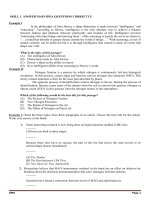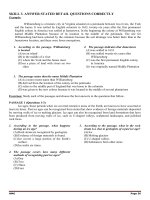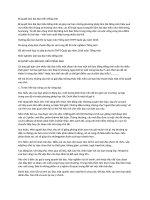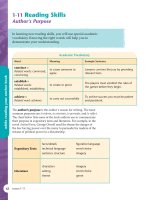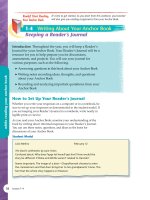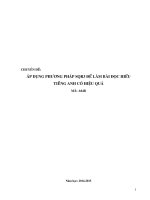Bài đọc hiểu tiếng anh
Bạn đang xem bản rút gọn của tài liệu. Xem và tải ngay bản đầy đủ của tài liệu tại đây (88.65 KB, 12 trang )
1. Hãy đọc đoạn văn sau và chọn câu trả lời tốt nhất trong số A, B, C và D.
Because writing has become so important in our culture, we sometimes think of it as
more real than speech. A little thought, however, will show why speech is primary and
writing secondary to language. Human beings have been writing.(as far as we can tell
from surviving evidence) for at least 5000 years; but they have been talking for much
longer, doubtless ever since there have been human beings.
When writing did develop, it was derived from and represented speech, albeit
imperfectly. Even today there are spoken languages that have no written form.
Furthermore, we all learn to talk well before we learn to write; any human child who is
not severely handicapped physically or mentally will learn to talk, a normal human being
cannot be prevented from doing so. On the other hand, it takes a special effort to learn to
write; in the past many intelligent and useful members of society did not acquire the skill,
and even today many who speak languages with writing systems never learn to read or
write, while some who learn the rudiments of those skills do so only imperfectly.
To affirm the privacy of speech over writing is not, however, to disparage the latter.
One advantage writing has over speech is that it is more permanent and makes possible
the records that any civilization must have. Thus, if speaking makes us human, writing
makes us civilized.
1. The author of the passage argues that _______.
A. writing has become too important in today’s society
B. speech is more basic to language than writing
C. everyone who learns to speak must learn to write
D. all languages should have a written form.
2. According to the passage, writing _______
A. is imperfect, but less so than speech
B. represents speech, but not perfectly
C. developed from imperfect speech
D. is represented perfectly by speech
3. In the author’s judgement _______.
A. writing has more advantages than speech
B. speech is essential but writing has important benefits
C. speech conveys ideas less accurately than writing does
D. writing is more real than speech
4 In order to show that learning to write requires effort, the author gives the example of
_______.
A. people who learn the rudiments of speech
B. people who speak many languages
C. intelligent people who couldn’t write
D. severely handicapped children
5. According to the author, one mark of civilized society is that it _______
A. affirms the primacy of speech over writing
B. affirms the primacy of writing over speech
C. teaches its children to speak perfectly
D. keeps written records
2. Hãy đọc đoạn văn sau và chọn câu trả lời tốt nhất trong số A, B, C và D.
Concern about the gypsy moth has been growing in Michigan. The moth larva, a twoinch long furry caterpillar, is a ravenous eater of tree leaves. These larvae defoliate entire
groups of trees, and through repeated defoliation, the trees eventually die. This type of
tree loss is a major concern to the timber and paper industries, both of which depend on
the well-being of Michigan’s woodlands. The gypsy moth is also of concern to
recreational users of Michigan’s forests. Some areas are nearly unusable due to the large
number of caterpillars that drop from the trees onto campsites, cabins, and trails.
To deal with this problem, the Michigan Forestry Department needed to assess to
what extent the moth threatened timberlands. Before launching extensive pesticide
spraying programmes, which present their own dangers to wildlife, a thorough
understanding of the problem was-needed. For this the department turned to John
Whitter, a forest entomologist.
Whitter has been investigating the relation between tree species and the proliferation
of the gypsy moth larvae. He has found that aspen and red and white oak trees are the
preferred food of the moth larvae; they rarely feed on red maple. Because of this, it is
likely that northern Michigan forests will see a shift toward the red maple as oak and
aspen are destroyed by the moth. Whitter’s research has further determined where tree
death is caused by the gypsy moth and where drought or other stresses may be the cause.
With this information the Forest Department is much better equipped to find a solution to
the gypsy moth problem.
1 According to the passage, when do gypsy moths do the most damage?
A when they are larvae
B. when they attack caterpillars
C. after they are sprayed with pesticides
D. when there is a drought
2 Which of the following is NOT true about gypsy moths?
A. They can bother tourists
B. They can bother wildlife
C. They can kill trees D. They can harm certain businesses
3. What problem with pesticides does the passage mention?
A. They are costly
B. They don’t kill all varieties of the gypsy moths
C. They can be harmful to humans
D. They may harm wild plants and animals
4. What did John Whitter do for the Forestry Department?
A. He developed new pesticides that won’t harm wildlife
B. He found a solution to the gypsy moth problem
C. He studied the gypsy moth problem
D. He recommended which pesticides to use
5. It can be inferred that before Whitter’s work,_______
A. pesticides were more dangerous than they are now
B. people didn’t know whether drought or moths had killed certain trees
C. red maples were endangered by gypsy moths
D. the gypsy moth population was controlled by periodic drought
3. Hãy đọc đoạn văn sau và chọn câu trả lời tốt nhất trong số A, B, C và D.
High in the hills of the Dominican Republic, hundreds of narrow openings tunnel into
the world’s second richest source of amber. For scientists, the ancient tree resin found in
these tunnels brings a glimpse into the ancient life in the West Indies through perfectly
preserved prehistoric creatures. For mine owners and miners it provides a steady source
of income.
Germ-like in its rich shades of gold, orange, brown, and rarely, blue, the fossilized
tree sap has been used as a decoration and good luck charm since the Stone Age. The
largest and most accessible source is the Baltic coast of Northern Europe, where the resin
is easily mined in shoreline deposits and sometimes even washes up on beaches. Other
deposits have been found in Australia, China, and the Middle East. But it is in the dense
subtropical hills of the Dominican Republic that some of the most valuable amber
samples - those containing prehistoric insects - are found.
Millions of years ago, trees from now-vanished forests produced a sticky substance
that slowly hardened into sparkling rocks. Often, the hardening sap would drip onto an
unlucky grasshopper or beetle, encasing it in a premature tomb. Today a piece of amber
with such contents is worth thousands of dollars. However, not long ago, miners tossed
out these pieces, believing them to be flawed and worthless. The preservation of creatures
in amber is amazing. Scientists are able to cut the amber and expose the actual structures
of a prehistoric creature’s muscles, eyes, jaws, and. nervous systems.
Although amber supplies are declining in some areas of the world, it is doubtful that
the supplies will be depleted any time soon. New-deposits are always being discovered,
guaranteeing a rich link to the past.
1. Where is amber found?
A. primarily in tropical regions B. in both tropical and moderate climates
C. usually in hilly regions
D. usually in forests
2. According to the passage, amber has been used as a decoration because _______.
A. it is extremely rare
B. it contains prehistoric insects
C. its colour is similar to that of precious stones
D. it is easy to form into various shapes
3. Why did miners throw away pieces of amber that contained beetles?
A. They thought they were unlucky
B. They thought the exposed structures were harmful
C. They were too hard to crack open
D. They thought they were imperfect
4 What is the easiest way to get amber?
A. mine it in tunnels
B pick it up off a forest floor
C. pick it up along a shore
D dig it out of insect nests
5 Why do some pieces of amber contain grasshoppers’?
A. They were placed there to increase the value of the amber
B. The grasshoppers lived in the tunnels where amber is found
C. The grasshoppers liked to eat the sap
D. The sticky resin trapped them.
4. Hãy đọc đoạn văn sau và chọn câu trả lời tốt nhất trong số A, B, C và D.
Concrete, a rock-like substance used to make bridges and highways, is made by
mixing powered cement, the adhesive ingredient, with water and an aggregate such as
pebbles or sand. The process of mixing concrete is tricky, like gourmet cooking. Too
much water weakens concrete; too little makes the cement so stiff it won’t mix or pour.
Temperature also is critical; if it is too cool, the chemical reaction goes too slowly; if it is
too hot, it goes too fast, thus weakening the concrete.
But even carefully brewed concrete is by its very nature flawed. Not matter how
dense it seems, it is a maze of tiny tunnels. Concrete actually is porous, like a sponge - it
can absorb up to ten percent of its weight in water. All sorts of things can seep into those
pores and spoil the concrete. One villain is water, which expands nine percent when it
freezes, breaking open the pores and making them wider. Then more water can get in and
freeze, causing the concrete to crumble. Engineers, however, have discovered a solution -
an industrial detergent derived from pine sap. Added to the cement mix, the detergent
creates isolated micro bubbles in the concrete. When moisture in the concrete freezes and
expands, the bubbles give the water a place to go.
Another problem that may occur because of the nature of these materials is an alkaliaggregate reaction. Most cement is composed of limestone and clay, and is highly
alkaline. The stone aggregates are primarily quartz, or silica. Silica comes in two forms,
crystalline or glassy. The crystalline form poses no problem. But glassy silica dissolves in
alkalis, producing a silica gel. This gel absorbs moisture, which in turn can expand and
crack the concrete.
1. Although hardened concrete seems solid, it _______.
A. can expand nine percent
B. is made primarily from water
C. can flow into pores
D. contains many small holes
2 The author compares the process of making concrete to that of _______
A building structures
B. experimenting in a laboratory
C preparing fine food
D. solving a mystery
3. What can prevent the formation of silica gel?
A use of a detergent
B. use of additional alkalis
C. use of glassy silica
D. use of non-glassy quartz
4 What property of water makes it destructive to concrete?
A. It increases in size when frozen
B. It slows down chemical reactions
C. It cools very quickly
D. It dissolves silicas
5. What action, described in the passage, can prevent environmental damage to
concrete?
A. wash it with industrial detergents
B. create space for water expansion
C. impose temperature controls
D. add an aggregate that is alkaline
5. Hãy đọc đoạn văn sau và chọn câu trả lời tốt nhất trong số A, B, C và D.
Although Edgar Allan Poe is recognized as the originator of the mystery story genre
and as a master of the short story, literary critics and the general public have debated the
extent of both his genius and his madness since his death in 1849. Poe rose from destitute
beginnings as an orphan to a childhood of relative comfort when a wealthy businessman
took him in. As a young man, however, he descended through poverty and mental illness
to an early death at the age of forty. In his short career, he produced dozens of poems,
stories, and critical essays that reflect his brilliant creative intellect.
At twenty, Poe moved to Baltimore to live with his impoverished aunt and her
daughter, where he eventually married his fourteen-year-old cousin, Virginia. Poe was
obviously devoted to his young wife, and idealized images of her appear in many of his
female characters. It is difficult to suppose, however, that they had a close relationship,
since she was many years younger than he was and chronically ill with tuberculosis.
Although Poe wrote for various newspapers and magazines during this time, making
great strides in literary criticism and developing his short-story style, he achieved no
monetary success.
His sensitive personality and a hereditary tendency to neurosis contributed to a tragic
mental decline; however, this only seems to have reinforced the brilliant imagery and
fascinating morbidity that he achieved in his tales. Many critics speculate that Poe also
suffered from alcoholism and opium addiction. The fantastical quality of his work earned
him a devoted posthumous following in France, but he was generally disparaged by his
American contemporaries.
1. According to the passage, some of the women in Poe’s works were inspired by his
_______.
A. daughter
B. mother
C. cousin
D. aunt
2. What does the author claim strengthened the imagery of Poe’s tales?
A. his mental deterioration
B. his interest in literary criticism
C. his alcoholism and opium addiction
D. his posthumous following in France
3. According to the author, critics disagree about _______
A. Poe’s relationship with his wife
B. the degree of Poe’s talent
C. whether Poe was a better as a critic than as a poet
D. the meaning of the fantastic images in Poe’s work
4. When Poe-wrote for magazines, he _______
A. became ill with tuberculosis
B. became popular in France
C. was financially successful
D. improved his writing technique
5. Just after Poe’s death, his reputation as a writer was better _______
A. in France than in the U.S.
B. in the U.S. than in France
C. than it is now
D. amongst critics than the general public
6. Hãy đọc đoạn văn sau và chọn câu trả lời tốt nhất trong số A, B, C và D.
Only humans have a spoken, symbolic language; scientists have long thought that
nonhuman primates had much less sophisticated communication systems. True, but
chimpanzees use gestures and many voice sounds in the wild, while other apes use
sounds to communicate territorial information. Chimpanzees seem to have a natural talent
for learning symbolic language under controlled conditions. A famous chimpanzee named
Washoe was trained to communicate with humans using no less than 175 sign language
gestures similar to those of the American Sign Language. After more than a year Washoe
could associate particular signs with activities, such as eating and drinking. Another
chimpanzee named Sarah was taught to read and write with plastic symbols and acquired
a vocabulary of 130 different words, to the extent that she obeyed sequences of written
instructions given with the symbols. But such experiments in communication with
primates are a far cry from the versatility and grace of human speech.
1. According to the passage, all of the following are true of chimpanzee communication
EXCEPT _______
A. it is less sophisticated than human language
B. it is observable in the wild
C. it uses gestures
D. it is as versatile as human communication
2. The passage states that the ability of chimpanzees to learn symbolic language in
certain situations is due to _______.
A. their territoriality
B. their use of gestures and voice sounds in the wild
C. their natural talent
D. their use of the American Sign Language
3. According to the passage, the chimpanzee Washoe _______.
A. was able to associate some signs with activities after a year
B. used fewer than 175 signs to communicate
C. was fluent in the American Sign Language
D. could read and write
4. The passage states that Sarah’s ability to read and write was judged by _______
A. the size of her vocabulary
B. her dexterity in using the plastic symbols
C. her obedience to instructions given in the symbol language
D. the number of symbol sequences that she could manipulate
5. According to the author, spoken, symbolic language is _______
A. not a sophisticated communication system
B. only available to humans
C. shared by both humans and chimpanzees
D. similar to the language used by chimpanzees
7. Hãy đọc đoạn văn sau và chọn câu trả lời tốt nhất trong số A, B, C và D.
Reading to oneself is a modem activity which was almost unknown to the scholars of
the classical and medieval worlds, while during the fifteenth century the term ‘reading’
undoubtedly meant reading aloud. Only during the nineteenth century did silent reading
become commonplace.
One should be wary, however, of assuming that silent reading came about simply
because reading aloud is a distraction to others. Examination of factors related to the
historical development of silent reading reveals that it became the usual mode of reading
for most adult reading tasks mainly because the tasks themselves changed in character.
The last century saw a steady gradual increase in literacy, and thus in the number of
readers. As readers increased so the number of potential listeners declined, and thus there
was some reduction in the need to read aloud. As reading for the benefit of listeners grew
less common, so came the flourishing of reading as a private activity in such public
places as libraries, railway carriages and offices, where reading aloud would cause
distraction to other readers.
Towards the end of the century there was still considerable argument over whether
books should be used for information or treated respectfully and over whether the reading
of material such as newspapers was in some way mentally weakening. Indeed this
argument remains with us still in education. However, whatever its virtues, the old shared
literacy culture had gone and was replaced by the printed mass media on the one hand
and by books and periodicals for a specialised readership on the other.
By the end of the century students were being recommended to adopt attitudes to
books and to use skills in reading them which were inappropriate, if not impossible, for
the oral reader. The social, cultural, and technological changes in the century had greatly
altered what the term ‘reading’ implied.
1. Why was reading aloud common before the nineteenth century?
A. Silent reading had not been discovered.
B. There were few places- available for private reading.
C. Few people could read for themselves.
D. People relied on reading for entertainment
2. The development of silent reading during the nineteenth century indicated _______
A. a change in the status of literate people.
B. a change in the nature of reading.
C. an increase in the number of books.
D. an increase in the average age of readers.
3. Educationalists are still arguing about _______.
A. the importance of silent reading.
B. the amount of information yielded by books and newspapers.
C. the effects of reading on health.
D. the value of different types of reading material.
4. The emergence of the mass media and of specialised periodicals showed that
_______.
A. standards of literacy had declined.
B. readers’ interests had diversified.
C. printing techniques had improved.
D. educationalists’ attitudes had changed.
5. What is the writer of this passage attempting to do?
A. explain how present-day reading habits developed.
B. change people’s attitudes to reading.
C. show how reading methods have improved.
D. encourage the growth of reading.
8. Hãy đọc đoạn văn sau và chọn câu trả lời tốt nhất trong số A, B, C và D.
Although speech is the most advanced form of communication, there are many ways
of communicating without using speech. Signals, signs, symbols, and gestures may be
found in every known culture. The main function of a signal is to impinge upon the
environment in such a way that it attracts’ attention, as for example, the dots and dashes
of a telegraph circuit. Coded to refer to speech, the potential for communication is very
great. Less adaptable to the codification of words, signs also contain meaning in and of
themselves. A stop sign or a barber pole conveys meaning quickly and more difficult to
describe than either signals or signs because of their intricate relationship with the
receiver’s cultural perceptions. In some cultures, applauding in a theatre provides
performers with an auditory symbol of approval. Gestures such as waving and
handshaking also communicate certain cultural messages.
Although signals, signs, symbols, and gestures are very useful, they do have a major
disadvantage. They usually do not allow ideas to be shared without the sender being
directly adjacent to the receiver. As a result, means of communication intended to be used
for long distances and extended periods are based on speech. Radio, television, and the
telephone are only a few.
1. Which of the following would be the best title for the passage?
A. Signs, Signals, and Symbols
B. Gestures
C. Communication
D. Speech
2. What does the author say about speech?
A. That it is the only true form of communication.
B. That it is dependent upon the advances made by inventors.
C. That it is necessary for communication to occur.
D. That it is the most advanced form of communication.
3. Applauding was cited as an example of _______
A. a sign
B. a signal
C. a symbol
D. a gesture
4. Why were the telephone, radio, and TV invented?
A. Because people were unable to understand signs, symbols, and signals.
B. Because people wanted to communicate across long distances.
C. Because people believed that signals and symbols were obsolete.
D. Because people wanted new forms of entertainment.
5. It may be concluded from this passage that _______
A. signals, signs, symbols, and gestures are forms of communication.
B. symbols are very easy to define and interpret.
C. only some cultures have signals and symbols.
D. waving and handshaking are not related to culture.



